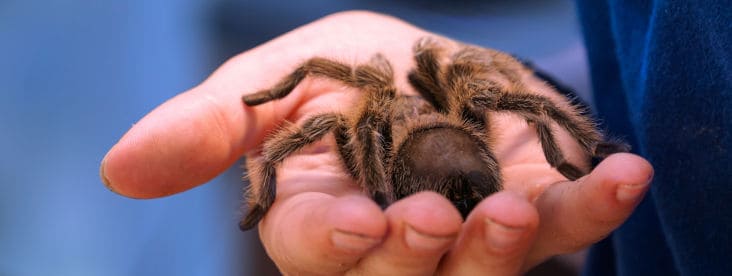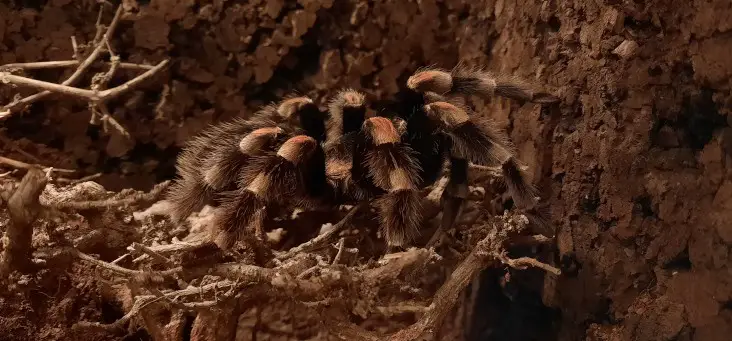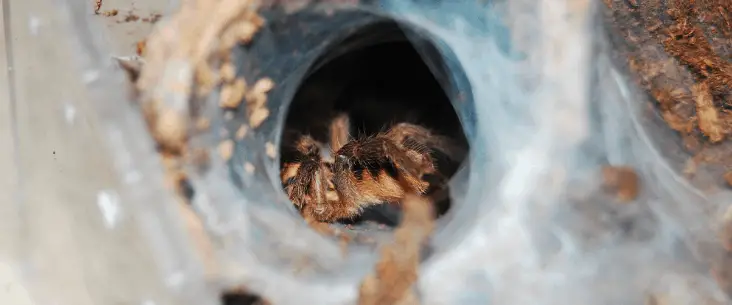You have probably seen it many times on pictures and video: A kid or adult holding a tarantula. Although they have a bad reputation because of all the horror movies, tarantulas have become popular pets because of their massive size and hairy bodies. But are tarantulas dangerous as pets?
Most tarantulas are relatively harmless to humans and can be safe pets to have. As for most tarantulas, a bite will rarely cause serious harm or an allergic reaction. However, when they fling their urticating hairs at you can be extremely irritating to the eyes and mucous membranes.
Although tarantulas can make great pets that are generally slow-moving and docile creatures, there is a risky side note you should be aware of.

Is a tarantula a dangerous pet?
Hollywood is probably the blame for these largest-of-all spiders’ bad reputation. They are often used in horror movies where they picture the tarantula as creepy, dangerous and toxic. But if they really were dangerous, they wouldn’t use it in movies, right?
Although they possess venom, it is rarely lethal to humans. And tarantulas that are sold in the pet industry are absolutely not deadly. You can’t even call them dangerous. Most of the tarantulas are calm creatures, minding their own business.
Actually, tarantulas are making great pets for a lot of people. They don’t have high requirements and don’t use much space. And several species are even suitable to handle. It is not that they particularly like that or they like humans’ presence, but they won’t attack you if there is no reason for it.
But, what is all the fuzz about then?
What are the risks of keeping a tarantula as pets?
Although tarantulas make good pets, they can use one of their defence mechanisms if they feel threatened. They can defend themselves by using their fangs for a venomous bite or shooting their urticating hairs.
First, the bite. It sounds very frightening, but with most species, it is nothing more than a bee sting, and most tarantulas have very low toxicity to humans. A bite or scratch from a cat, or a bite from a corn snake, is just as painful or in some cases even more painful than a bite from a tarantula. It is mostly the thought of a spider that bites you. Don’t worry; you won’t become spiderman!
And then you need to understand when a tarantula bites. Because they normally won’t do that without reason. And that reason is that they feel threatened and don’t see any other solution to escape the situation. The risk of being bitten is, therefore, mostly when they are handled. And even before they bite, they make enough signals that they don’t like the situation, such as a threatening pose.
But even before a tarantula will bite, they may shoot their urticating hairs, or simply called bristles, from their back towards you. These hairs have tiny hooks which sting in your skin, eyes and mucous membranes. These hairs can be very itching and irritating. Maybe this is even more annoying and irritating than the bite.
Be aware that the tarantula’s substrate can be covered with these bristles. When cleaning the enclosure or substrate, these hairs can blow up, which may be very itching. Wearing gloves would be wise in this case, or use tools that increase the distance between your hands and the substrate.
However, these risks are generally minimal when you just have your tarantula in the enclosure and normally feed them with a tweezer or let the feeder insect fall in the enclosure — I guess they would otherwise not be such a popular pet. So, there is nothing to be scared off when keeping tarantulas. You only need to be careful when you need (or wish) to handle them or when you clean the enclosure.
Interested in keeping tarantulas?
Do you consider keeping a tarantula as a pet? They can be a perfect pet, but it is important to understand the basic care requirements before deciding to buy one. Check out our basics guide on how you can keep and what you need to take proper care for your pet tarantula.

Should you handle tarantulas?
Now, most of you know that you can handle tarantulas. Many tarantulas are calm and docile creatures, and you can find many photos and videos of people holding their pet tarantula. Although it is awesome to hold a tarantula on your hand, the main question is if you should handle your tarantula? There are some things to consider.
First of all, if you wish to hold your animal or not is totally up to you. I know it is always a debate if and why you should handle your tarantula. There is also not a clear answer to this question, though.
In my opinion, handling tarantulas does not bring any perks to your animal. Handling is mostly for the keeper itself. It gives bonding with your animal, or you get to know your animal better. But it is not that a tarantula intrinsically likes to be handled. Some individuals are (as it seems) perfectly fine being picked up, but most tarantulas are totally fine with all legs in their enclosure. They don’t have any need for social interaction or affection by you as a keeper. They can live completely healthy and happy for 25 years being in their enclosure on their own.
On the other hand, the risk that a tarantula hurts you is almost limited only when you try to handle your tarantula. Otherwise, the animal would generally not try to attack you. I personally prefer to have a hands-off policy.
Important note: I do not intend you to dissuade or judge from handling and holding your tarantula. If you can safely pick up your tarantula, that is awesome. But I think it is important to consider the animal’s perspective at least before you try to pick up your tarantula. A good extensive article on this topic can be found here.

Which tarantulas are (more) suitable for beginners?
There are several tarantulas that are more suitable for beginners. They have a more docile and calm temperament, are easier to house and care for, and are readily available and aren’t too expensive to purchase. If you are a beginner definitely check out these beautiful tarantulas:
- Brachypelma albopilosum / Curlyhair tarantula
- Brachypelma smithi / Mexican redknee tarantula
- Grammostola pulchripes / Chaco golden knee tarantula
- Grammostola pulchra / Brazilian black tarantula
- Grammostola rosea / Chilean rose tarantula
- Chromatapelma cyaneopubescens / Greenbottle blue tarantula
- Euathlus parvulus / Chilean gold burst tarantula
- Eupalaestrus campestratus / Pink zebra beauty tarantula
I recommend you to always read more about the species. You need to know the best way to keep them because not all tarantula species are housed and cared for in the same way. Every species have an optimal climate range, tank decoration, and food preferences.
Besides that, you must understand that tarantulas can get quite old. When you buy a young spiderling tarantula, several species (at least the female) can get over 20 years with proper care. So understand that keeping tarantulas is a long-term commitment. Therefore it is important to make a well-thought choice.
Maybe not a tarantula then, but…
Maybe after reading this article, you think a tarantula is not suited for you. But there are more bugs that can be amazing pets. Check out these other animals, maybe these are a better pet for you?
– Praying mantis
– Giant millipede
– Ant colony
Share this page!



